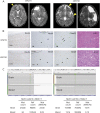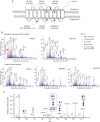Brain somatic mutations in SLC35A2 cause intractable epilepsy with aberrant N-glycosylation
- PMID: 30584598
- PMCID: PMC6283456
- DOI: 10.1212/NXG.0000000000000294
Brain somatic mutations in SLC35A2 cause intractable epilepsy with aberrant N-glycosylation
Abstract
Objective: To identify whether somatic mutations in SLC35A2 alter N-glycan structures in human brain tissues and cause nonlesional focal epilepsy (NLFE) or mild malformation of cortical development (mMCD).
Methods: Deep whole exome and targeted sequencing analyses were conducted for matched brain and blood tissues from patients with intractable NLFE and patients with mMCD who are negative for mutations in mTOR pathway genes. Furthermore, tissue glyco-capture and nanoLC/mass spectrometry analysis were performed to examine N-glycosylation in affected brain tissue.
Results: Six of the 31 (19.3%) study patients exhibited brain-only mutations in SLC35A2 (mostly nonsense and splicing site mutations) encoding a uridine diphosphate (UDP)-galactose transporter. Glycome analysis revealed the presence of an aberrant N-glycan series, including high degrees of N-acetylglucosamine, in brain tissues with SLC35A2 mutations.
Conclusion: Our study suggests that brain somatic mutations in SLC35A2 cause intractable focal epilepsy with NLFE or mMCD via aberrant N-glycosylation in the affected brain.
Figures


References
-
- Duncan JS, Sander JW, Sisodiya SM, Walker MC. Adult epilepsy. Lancet 2006;367:1087–1100. - PubMed
-
- Schuele SU, Lüders HO. Intractable epilepsy: management and therapeutic alternatives. Lancet Neurol 2008;7:514–524. - PubMed
-
- Epi4K consortium; Epilepsy Phenome/Genome Project. Ultra-rare genetic variation in common epilepsies: a case-control sequencing study. Lancet Neurol 2017;16:135–143. - PubMed
LinkOut - more resources
Full Text Sources
Miscellaneous
